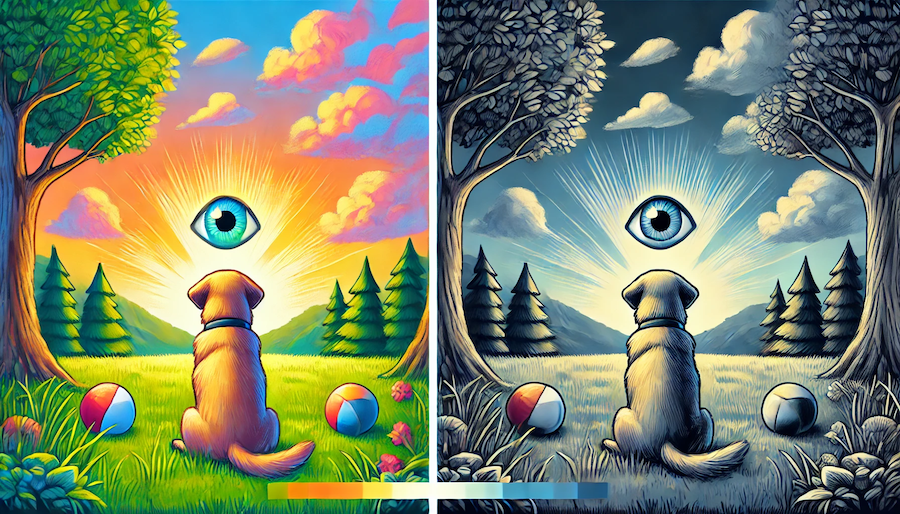For decades, the myth that dogs see only in black and white persisted. However, scientific research has revealed that while a dog’s color perception differs from humans, they do indeed see colors. This article delves into the fascinating world of canine color vision, exploring how dogs perceive colors, the biological basis for their vision, and how this affects their daily lives.
The Basics of Color Vision
To understand dog color vision, it’s essential to first grasp the basics of how color vision works:
- Photoreceptors: The retina contains two types of photoreceptors – rods and cones. Rods are responsible for detecting light levels and motion, while cones are responsible for color vision and detail.
- Types of Cones: Humans typically have three types of cones, each sensitive to different wavelengths of light:
- Short-wavelength (S) cones: sensitive to blue light
- Medium-wavelength (M) cones: sensitive to green light
- Long-wavelength (L) cones: sensitive to red light
- Color Perception: The brain interprets the signals from these cones to create the perception of color.
Canine Color Vision
Dogs’ color vision differs from humans in several key ways:
- Dichromatic Vision: Unlike humans who are typically trichromats (having three types of cones), dogs are dichromats. They have only two types of cones:
- One similar to the human short-wavelength (S) cone, sensitive to blue-violet light
- Another that falls between the human medium and long-wavelength cones, sensitive to yellow-green light
- Color Spectrum: Due to their dichromatic vision, dogs see a more limited color spectrum compared to humans. Their world primarily consists of yellows, blues, and grays.
- Red-Green Colorblindness: Dogs cannot distinguish between red, green, and orange. These colors appear yellowish or brownish to them.
- Blue-Yellow Distinction: Dogs can easily distinguish between blue and yellow, which appear as distinct colors to them.
The Science Behind Canine Color Vision
The differences in canine color vision stem from evolutionary adaptations:
- Evolutionary Purpose: Dogs evolved from wolves, which are primarily crepuscular (active at dawn and dusk) hunters. Color vision was less critical for survival than the ability to detect motion and see in low light conditions.
- Rod Dominance: Dogs have more rods in their retinas compared to humans, which enhances their ability to see in dim light and detect motion.
- Tapetum Lucidum: Dogs possess a reflective layer behind the retina called the tapetum lucidum, which enhances their night vision but may slightly reduce visual acuity.
Implications of Canine Color Vision
Understanding a dog’s color perception has several practical implications:
- Toy Selection: When choosing toys for dogs, opt for blue or yellow colors, which they can easily distinguish.
- Training Aids: Use blue and yellow objects or markers for training exercises to make them more visible to dogs.
- Agility Courses: In dog sports, equipment colored in blue and yellow may be more easily distinguishable for dogs.
- Environmental Enrichment: When designing spaces for dogs, consider using color contrasts they can perceive to create visually stimulating environments.
Comparing Human and Canine Vision
While dogs may see fewer colors than humans, their visual system has several advantages:
- Motion Detection: Dogs are significantly better at detecting motion, even at long distances.
- Peripheral Vision: With eyes positioned more to the sides of their heads, dogs have a wider field of view than humans.
- Night Vision: Thanks to their rod-dominant retinas and tapetum lucidum, dogs can see much better than humans in low light conditions.
Conclusion
The canine visual world, while different from our own, is rich and vibrant in its own right. Dogs may not see the full spectrum of colors that humans do, but their visual system is well-adapted to their needs. Understanding how dogs perceive colors not only satisfies our curiosity but also helps us create better environments and interactions for our canine companions.
As research in this field continues, we may uncover even more fascinating aspects of canine perception, further deepening our understanding of man’s best friend.

